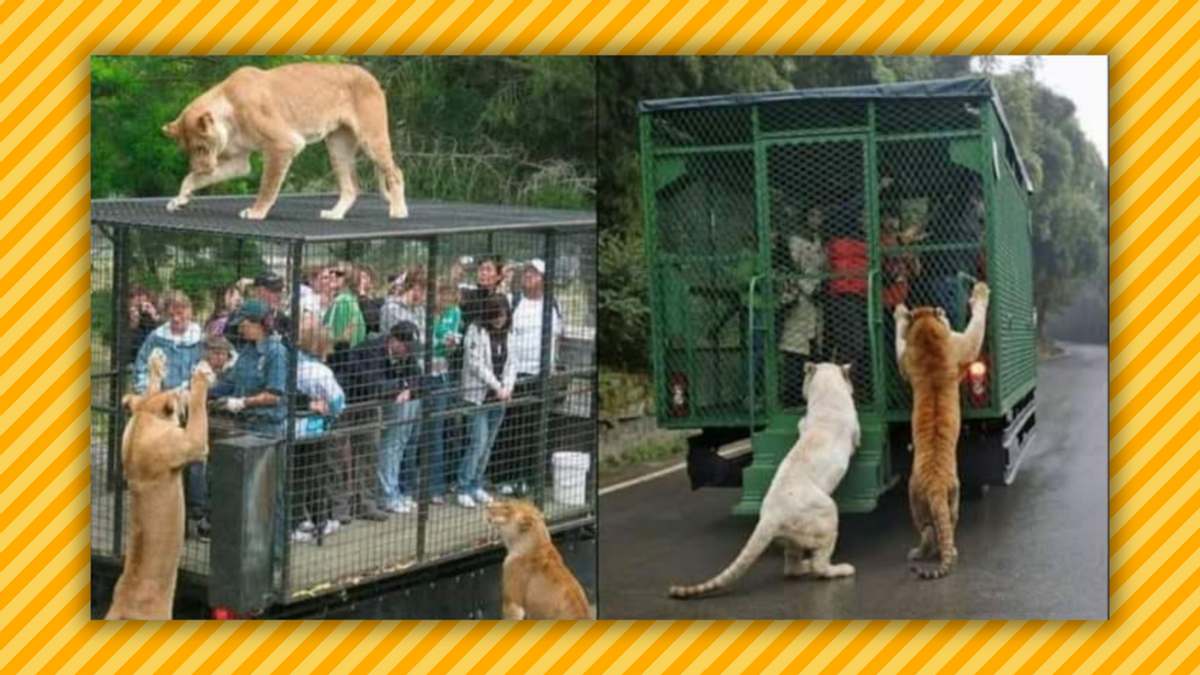Fact Check: 'Reverse Zoo' in China Allegedly Cages Human Visitors and Lets Animals Roam Free

Claim:
A "reverse zoo" exists in China that puts visitors inside cages and allows the animals to roam free.
Rating:
What's True:
Lehe Ledu Theme Park is an actual place in China, and it does have a safari attraction wherein visitors can ride in mobile cages and see the animals close up ...
What's False:
... but that's not the only way to see the animals. Visitors can also travel around in buses, or even in their own cars. There's also an area where you can walk around and see some of the animals in a less-restricted setting.
In April 2024, an image circulated on social media, claiming a "reverse zoo" exists in China that puts visitors inside cages and allows the animals to roam free. As of this writing, one post received over 67,000 reactions, 2,000 comments and 5,200 shares.

(Facebook page Factoidz)
Google reverse-image search results showed that the same claim was also spread on Reddit, Instagram, X (formerly Twitter), Facebook, and TikTok.
Various articles on the topic indicated that the viral photographs were captured in "Lehe Ledu wildlife zoo in Chinese Chongqing City," opened in 2015.
New China TV, a Chinese state-owned YouTube channel, published a video with the title, "Caged visitors pay to feed tigers, lions at China zoo." Its description said a zoo in southwest China's Chongqing Municipality was "giving people the chance to feed some of the world's most ferocious animals on their own -- but in cages."
However, contrary to a viral rumor, Lehe Ledu Theme Park in China isn't best described as a "reverse zoo" wherein people are in cages and animals roam free, though it does have a safari attraction in which visitors are driven around in mobile cages. Visitors can also go around in buses or even their own cars. There's also an area where you can walk and see the animals directly.
Lehe Ledu is in Chongqing, China. We found it on Google Maps and a Chinese website Baidu Maps.
Moreover, we found Lehe Ledu Theme Park's official website: leheledu.com. It explained that there were three ways to visit the park's Wildlife World: in a sightseeing bus, on a self-driving tour or in an observation car, also called a "cage car" (we translated the following from Chinese using Google Translate, emphasis ours):
Ledu first recommends that everyone visit Chongqing Wildlife World.
(1) After entering the queuing area from the door, you will see the free sightseeing car that visits the animal car park area of the scenic spot.
On the sightseeing bus, you can see various beasts such as golden tigers, silver tigers, white tigers, Bengal tigers, lions, black bears, brown bears, wolves, etc.
(2) If you want to have a more exciting experience and experience the thrill of crossing among jungle beasts, it is recommended that you go on a self-driving tour (the check-in point for self-driving tours is at the entrance to the parking lot of the scenic spot from the direction of Yongchuan City. If you are not sure, please consult the on-site staff).
(3) If you want to get up close and feel the wild nature of predators, it is recommended that you take a ride on the net-type observation car (cage car) or feeding car next to the bus stop.
Therefore, the "cages" were only one of the possible options to see the animals in the zoo. What's more, the website informed that "after the tour of the vehicle area, we will get off at the entrance of the pedestrian area, namely Elephant Square." There is also a pedestrian area, known as Elephant Square. A promotional video of the park shows different angles of the park, including shots of the visitors feeding animals from the so-called cages.

(www.leheledu.com)
In other parts of the zoo, tourists can even be seen touching the animals (see screenshot below).

(www.leheledu.com)
In sum, Lehe Ledu Theme Park in China isn't accurately described as a "reverse zoo," as visitors also have options to tour the safari park by bus or car and explore pedestrian areas to observe the animals.
We have fact-checked other China-related claims in the past. For instance, in March 2024 we investigated whether a viral video showed a cliff walk in a Chinese national park. Moreover, we debunked a fake video shared in January 2024, allegedly showing a 1,200-meter-long grass slide in Inner Mongolia, China.
Sources:
- 乐和乐都动物主题乐园. 29 Nov. 2023, https://web.archive.org/web/20231129225512/https://www.leheledu.com/?a=scenic&navId=18.
Dapcevich, Madison. "Authentic Video of Hair-Raising Cliff Walk in Chinese Park?" Snopes, 28 Mar. 2024, https://www.snopes.com//fact-check/cliff-walk-china/.
"Lehe Ledu Theme Park." Lehe Ledu Theme Park, https://www.google.com/maps/search/Lehe+Ledu+Theme+Park/@29.2915012,105.9055445,1621m/data=!3m1!1e3?entry=ttu. Accessed 6 May 2024.
New China TV. Caged Visitors Pay to Feed Tigers, Lions at China Zoo. 2016. YouTube, https://www.youtube.com/watch?v=6CLn9SDTyHw.
Wrona, Aleksandra. "Does This Video Show a 1,200-Meter-Long Grass Slide in China?" Snopes, 24 Jan. 2024, https://www.snopes.com//fact-check/grass-slide-inner-mongolia-video/.
亲子攻略 丨 乐和乐都游玩攻略(建议) - 乐和乐都动物主题乐园. https://leheledu.com/index.php?m=Home&c=index&a=article&id=19. Accessed 6 May 2024.
亲子攻略 丨 让成长快乐发生,乐和乐都游玩攻略(视频) - 乐和乐都动物主题乐园. https://leheledu.com/index.php?m=Home&c=index&a=article&id=20. Accessed 6 May 2024.


